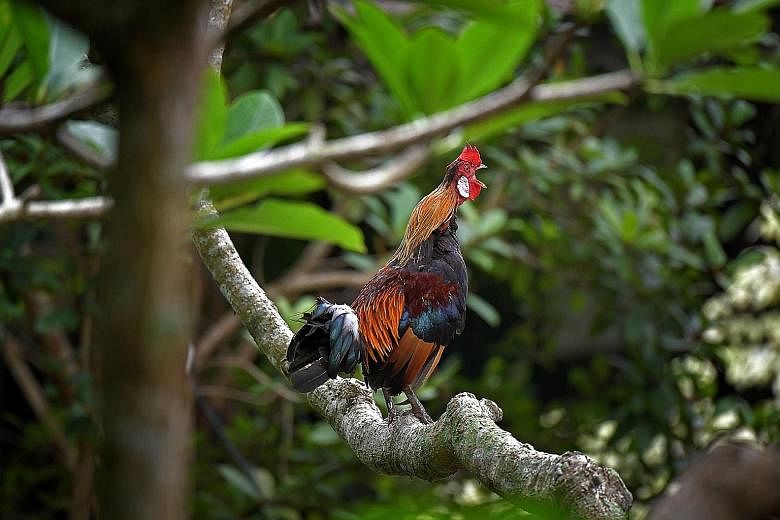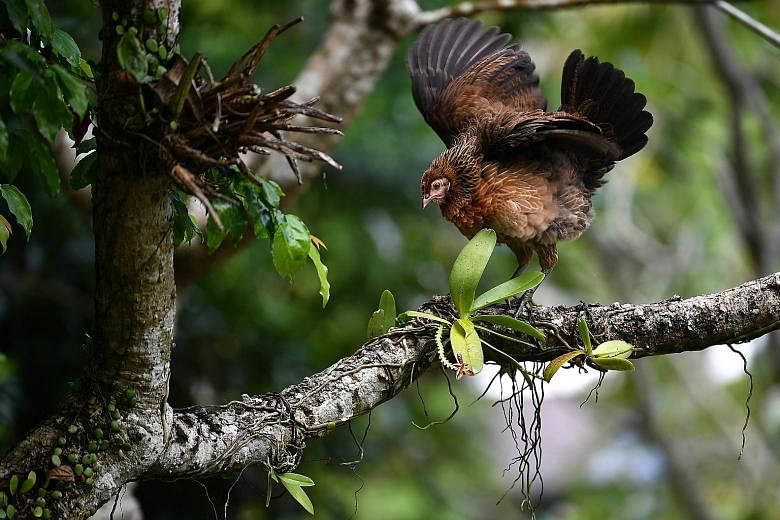As a ground-dwelling bird that looks like a domestic chicken, Singapore's endangered red junglefowl is often confused for being poultry.
However, a new study by scientists from the National University of Singapore (NUS) has shed light on how the domestic chicken and its wild ancestor can be distinguished at a glance.
For example, male red junglefowls usually sport dark green tail feathers and black primary feathers, while female red junglefowls are often distinguished from chickens by their grey legs and black primary feathers.
These findings could help researchers differentiate birds of conservation significance from domestic or wild chickens, even when they are roaming around together in a large flock.
CROSS-BREEDING
Years of intermingling between chickens and red junglefowl in Singapore has resulted in cross-breeding, and today, the birds on mainland Singapore span a range of genetic profiles.
Some birds have genetic profiles that are fairly close to domestic chickens, while others are genetically closer to wild red junglefowl, found the latest study, which was published last month in the scientific journal Evolutionary Applications.
The researchers, supervised by NUS ornithologist Frank Rheindt, determined this by first retrieving genetic samples from free-roaming birds and chickens from a poultry farm here.
These were then compared against wild red junglefowl "benchmarks" - historic museum specimens collected in Peninsular Malaysia in the late 19th and early 20th centuries.
As the specimens had been collected at a time when pristine habitats were separated from human dwellings by more substantial vegetated buffers, they likely had genotypes more closely related to "pure" red junglefowl due to reduced encounters with domesticated chickens, the researchers noted.
The red junglefowl was previously thought to be found mainly on offshore Pulau Ubin and the Western Catchment area, while birds in other parts of the island were assumed to be chickens.
But the latest study showed that red junglefowl can also be found islandwide.
The researchers then determined if there was a correlation between the way the birds looked and their genetic profiles. There was.
"Individuals that 'look pure' tend to score highly on our recommended panel of morphological traits," explained Associate Professor Rheindt.
"And as we would expect, these individuals are always characterised by a fairly unadmixed genotype, which means they are more closely related to the wild red junglefowl."
Birds that looked "pure" often also have genotypes more closely related to the wild types, but the reverse was not always true, the study found. Noted Prof Rheindt: "A few individuals that did not score very highly on morphological traits also had surprisingly unadmixed genotype too."
One likely reason for this is that the appearance of an organism - be it the colour of its plumage or its feet - is influenced by just a small part of its genetic code, he said.
If the genome of an organism reads like a book, then only parts of it - say, a sentence or chapter - determines its appearance.
So, while the appearance of a bird could hint at its genetic purity, it may not always give the full picture.
The latest study follows a culling controversy in 2017, when the authorities culled some free-ranging birds in Sin Ming estate to address concerns from residents who had complained about noise, and to mitigate the public health risk.
People were up in arms about the incident, commenting on social media and in forum letters saying the then Agri-Food and Veterinary Authority had reacted too quickly to the complaints of a few, especially since there was no immediate bird flu threat.
There were also concerns then that the culling efforts could have led to the red junglefowl being mistakenly killed as well, because members of the two species look alike.
FIRST OF ITS KIND
Dr Adrian Loo, group director of wildlife management at the National Parks Board (NParks), said the study was the first that looked into the extent of cross-breeding between domestic chickens and the red junglefowl in free-ranging chickens across mainland Singapore, and the visual traits useful for identifying a red junglefowl.
He said: "The study found that domestic chickens may affect the conservation of the red junglefowl due to the potential of cross-breeding with the latter."
"Gene flow from domestic or wild chickens into the wild red junglefowl populations can alter their genetic profile, and result in homogenisation and loss of genetic diversity, threatening the loss of the red junglefowl as a species."
NUS biologist Marcus Chua said wild animals have genetic make-ups that allow them to live and breed well in nature.
Domesticated animals, however, would often have been selectively bred for other traits that may not be ideal for living in the wild.
"Because of this, the genetic make-up of domestic animals is different from their wild counterparts," he said.
NParks' Dr Loo said wild red junglefowl may be relocated to nature areas to reduce their contact with domestic free-ranging chickens.
He said: "As part of the conservation of red junglefowl, we need to minimise the mixing with domestic chickens and will continue to enforce against abandoning or allowing domestic chickens to roam or public feeding, as this encourages mixing of domestic chickens with red junglefowl."
NParks will take reference from the study in using the recommended visual traits to assess whether a free-ranging chicken is likely to have the genomic profile of wild red junglefowl, added Dr Loo.
"We will also partner our local conservation community to strengthen the conservation of the red junglefowl and monitor their overall distribution and population size."
Dr Loo said NParks will continue to undertake studies involving experts to understand the population and ecology of free-ranging chickens and other urban birds, and explore various management measures.



